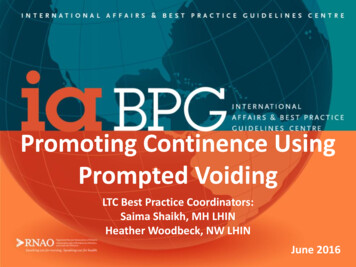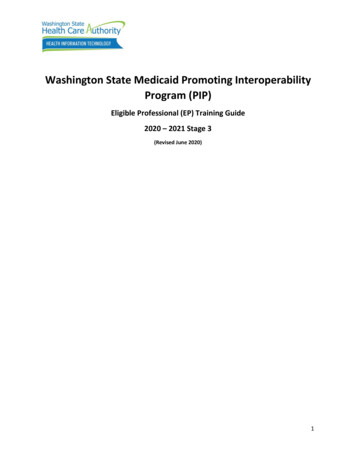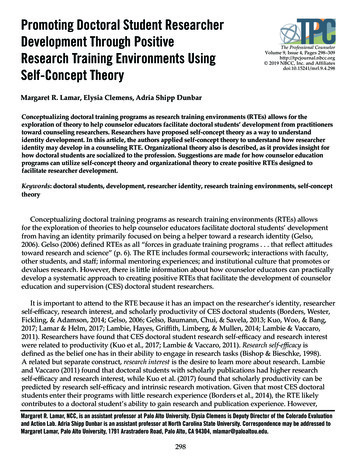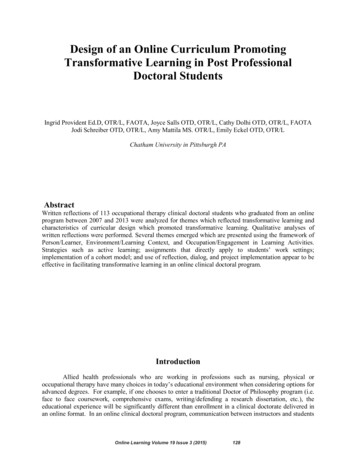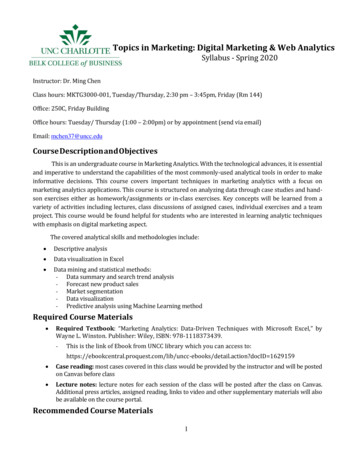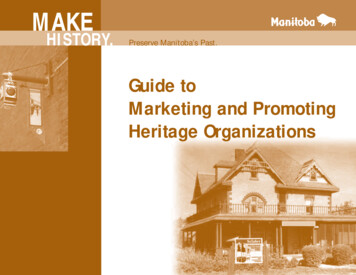
Transcription
MAKEHISTORY.Preserve Manitoba’s Past.Guide toMarketing and PromotingHeritage Organizations
2
What is this guide about?This guide outlines the basic steps of creating a marketing plan that will help promote yournon-profit community heritage organization to people in your community and to tourists.In promoting heritage organizations, two important principles apply:1. View programs and events as opportunities to promote your messageto the public.2. Design and create products and services to attract visitors.Marketing and promotional plans vary in terms of scope and depth, dependent upon theorganization and its resources. However, most plans follow these six steps:A. Establish the goal.B. Outline the objectives.C. Identify priority target groups.D. Prepare a budget.E. Develop an action plan (marketing and promotional program).F. Review and evaluate marketing and promotional programs regularly.This guide will explain the steps and then demonstrate how to apply them by creatinga marketing and promotional plan for the fictional Sclater Homestead Heritage Park, alsoreferred to as the museum. You will learn how to develop, apply and evaluate a two-yearmarketing plan.3
A word about competingManitoba has more than 250 community heritage organizations and all are competing forattention. With all this competition, you need to build a plan to attract visitors to your siteand interest new members and volunteers. When considering a plan, the first and mostimportant question to ask yourself is:What is it about this service or product that is of genuine interest to others?Once you have that answer, it is important that your staff and volunteers fully understandthe organization--its history and background. Agreeing on, and understanding anorganization’s purpose will help define the future direction and identify strengths andweaknesses that may be addressed in the action plan. It may also provide referencepoints for objectives (ex: increase number of visitors by 10%).The Manitoba Electrical Museum & EducationCentre developed a series of bookmarks topromote its museum.4A mission statement is a good starting point. If your heritage organization doesn’t haveone, you may find it helpful to develop one.
What is a mission statement?A mission statement succinctly explains why an organization exists and what ithopes to achieve.Sclater Homestead Heritage Park Mission Statement:Sclater Homestead Heritage Park is dedicated to preserving, studying and exhibitingcollections of artifacts that tell the story of Ukrainian pioneers between 1880 and 1940in the Parkland Region of Manitoba.In order to develop an effective marketing plan, staff and volunteers at Sclater HomesteadHeritage Park have been provided with the following history and background information.Sometimes, this type of information is referred to as the Situational Analysis.HistorySclater Homestead Heritage Park includes five acres located six kilometres south ofSclater, Manitoba, northeast of Duck Mountain Provincial Park. The property was formerlyowned by Wasyl and Paraska Pomonko, settlers who arrived from Ukraine in 1905. Wasylbecame a successful grain merchant in the Parkland Region and Paraska was a trustedand respected midwife.In 1969, Pomonko family descendants donated the 1920, two-storey brick house, itscontents, five acres of the original 164-acre property, farm equipment and threeoutbuildings to the Town of Sclater for use as a community museum and heritage park.In 1970, the town council established the Sclater Homestead Heritage Park in memoryof the Pomonko family and their life-long contributions to the Rural Municipality (RM)of Sclater and the Parkland Region of Manitoba.5
Background InformationThe Town of Sclater recently hired Sara Moroz as the museum’s new part-time (three daysa week) director/curator. Sara hired Eva Zeleni, a 16-week summer student though theCanadian Museums Association (CMA) under the Young Canada Works (YCW) in HeritageOrganizations program.About 65 members and 15 volunteers currently help operate, organize and host museumevents and activities. Revenue comes from: annual town, provincial and federal grants a local philanthropic foundation donations and fundraising three special holiday events admissionsAdults – 3.0055 plus – 2.00Youth ages 8 to 16 – 1.50Children under 8 years – free a gift shopThe Commonwealth AirTraining Plan Museumuses mobile advertisingto promote its facility.6
The museum is open daily from April 1 to October 31; by request from Novemberto March and; closed on holidays, except for three annual community events heldat the museum:- Remembrance Day Service and Reception in November- “Celebrate Christmas at the Farm” in December- “Celebrate Ukrainian Christmas at the Farm” in JanuaryThe museum fiscal year is April 1 to March 31. Last year, the museum’s revenuewas 10,000.00 and there were approximately 500 visitors.Unfortunately, all is not well with Sclater Homestead Heritage Park. Revenue andattendance have dropped, members and volunteers are dwindling and youth donot participate in the organization. The director/curator, Sara Moroz, has receivedapproval from the board of directors to proceed with two new initiatives to promotethe museum and raise its profile. The initiatives include:1. Use a 1,000.00 Pomonko family donation to develop a logo.2. Develop and execute a two-year marketing plan.Once staff and volunteers are familiar with your organization’s current situation,you’re ready to take the first step in developing an action plan.Electrosaurous, Manitoba Hydro’s Power Smartmascot is a creative educational tool used in theManitoba Electrical Museum & Education Centre.7
Six steps to developing a marketing and promotional action planA. Establish the GoalThough the words ‘goal’ and ‘objective’ may be interchangeable words in everyday life, in a marketingand promotional environment, there is a distinct difference between the two.Goals are broad statements. They are: general, one sentence statements of primary desired results means to create focus for the organizationMuseum’s Goal for Year 1 Raise public awareness of Sclater Homestead Heritage ParkB. Outline the ObjectivesObjectives are steps that will help achieve the goal.Large and colourful posters capture theattention and imagination of visitors tothe Commonwealth Air Training PlanMuseum. They will often form the basis of the action plan They often use the SMART formula:Specific - generating specific actions and strategiesMeasureable - attainment of an objective can be measuredAttainable - challenging but realisticRelevant - align with the goals and show directionTime-bound - subject to a specified time frameMuseum’s ObjectiveTell the story of Ukrainian settlers in the RM of Sclater between 1880 and 1940 (specific) forvisitors to the two-day Annual Sclater Harvest Fair (relevant), on the weekend of September 20and September 21 (time-bound).8
C. Identify Priority Target GroupsA target audience is a group of people toward whom a specific program or service isaimed. Identifying who is most likely to be interested or who will benefit from yourproduct or service will help determine your target audience(s).The number of target groups you may wish to identify depends on the product or service,and available resources.Here are some examples of audiences that might be targeted by a heritage group: museum members local or area residents visitors from elsewhere in Manitoba visitors from outside Manitoba (Canada, United States, Europe, Asia, etc.) organized bus tours people with strong ethnic or historical connections to the heritageorganization’s theme school children youth seniorsMuseum’s Target AudiencesPrimary: Adults with a strong ethnic or historical connection to the heritageorganization’s themeSecondary: Youth with a strong ethnic, historical or educational connectionto the heritage organization’s themeTertiary: Museum donorsSample of a bilingual pamphlet producedby Le Musée de Saint-Boniface Museum.9
D. Prepare a BudgetPreparing a budget is an important part of developing and applying an effective marketingand promotional program. Existing heritage organization revenue, grants from municipal,provincial and federal agencies and community philanthropic foundations are commonfunding sources. Financial assistance can also be obtained from individuals or donorsthrough monetary donations, endowments, bequests, services in-kind and tangible items,such as equipment and real estate. These donations can be designated by the donor for aspecific purpose or for general revenue. Gifts are acknowledged in a variety of ways. Thetype and level of acknowledgement typically reflects the donation amount. It can vary froma letter signed by the director to a plaque or even a media announcement for substantialdonations. Donors are given the opportunity of anonymity. Two other ways to raise moneyfor general revenue or promotional events for non-profit heritage organizations are: Sponsorship – Indirect Financial Assistance: Help businesses market their productsor services in exchange for their financial or in-kind support. Both partiesreceive value. Fund Raising – Direct Financial Assistance: Organize activities that require anadmission fee or solicit tangible support from individuals or organizations.The museum set the following budget:A poster promoting La Maison Gabrielle Royfeatures an image of the renown Canadianauthor and her St. Boniface home.10Display and demonstrate working Ukrainian pioneer homestead artifacts at the AnnualSclater Harvest Fair on September 20 and September 21. Provide visitor surveyattendance and feedback. Cost not to exceed 2,500.
How did the museum prepare its budget?The organization’s fiscal year is April 1 to March 31. The museum board of directorsmust approve all projects and budgets in the fiscal year prior. For example, if themuseum plans an event for September 20 and 21 at the Annual Sclater Harvest Fair, theprogram and funding must be approved by March 31, of the same year. Projects for thefollowing fiscal year must be approved on or before March 31, of the next year.In January, the board of directors tentatively approved the machinery and artifact displayand budget. In February, Sara Moroz, the director/curator, made a presentation to thetown council outlining the objective of the event and the draft budget. She requestedand received a grant for three newspaper advertisements, guard railings for machinerydisplays and a commitment from the council to add the museum event to the townwebsite. The council agreed, under the condition that the museum provides an eventupdate and final report.The board approved the program and final budget in March. With the objectives, targetaudiences, action plans and budget clearly identified and approved, Sara establishedan event committee comprised of the summer student, six museum members and 10museum volunteers. In July, the committee began to prepare for the two-day, September,museum event.The summer student, Eva Zeleni, was assigned the task of costing out all items relatedto the two-day fair and securing event sponsors. Eva was able to secure four impressivedonations for the fair. The Sclater Reporter donated in-kind services for the design,Ukrainian translation and printing of the event flyer and visitor survey. Only Organics, alocal organic farm, donated three gift baskets. Two Ukrainian churches agreed to includeevent information in their weekly newsletters and The Sclater Valley Boys volunteered toentertain the crowd with their lively Ukrainian music.The Costume Museum of Canadacreated a postcard to announceand celebrate its new location.11
Sclater Homestead Heritage Park BudgetSUPPLIESCOSTRentalthree tables, canvas canopy and six chairs 100.00Machinery-Artifactsset-up, demonstrate and dismantle 150.00Town Grantpurchase three advertisements in area 200.00newspaper and rental of guard railings formachinery displaysPurchasefood, serving and cleaning supplies 300.00In-Kind DonationOnly Organics: three Harvest Fair gift baskets 90.00 60.00Local radio station: four weeks ofpromotional spotsThe Sclater Reporter: two bilingual (English/Fort Dauphin Museum installed a prominent,commemorative plaque honouring Peter Fiddler,an explorer and surveyor. 1,200.00Ukrainian) event flyers and visitor surveyChurch Newsletters: two bilingual 50.00 250.00 100.00advertisements (English/Ukrainian)and event directional signageValley River Boys: musicMiscellaneous Expenses:TOTAL:12assorted items 2,500.00
E. Develop an Action Plan (Marketing and Promotional Program)Once the goal, objectives, target audiences and budget have been determined, you’re readyto start developing an action plan.Marketing and promotional programs are designed to communicate ideas, images andknowledge about an organization’s products and services. To ensure your message is reachingthe intended audience(s), here are four useful points to keep in mind when developing yourorganization’s program:1. Define the characteristics of the target audience(s). (See chart on next page.)Knowing your audience is essential when creating a message. Depending on the productor service, characteristics such as age, gender, ethnicity, occupation, and hobbies willhelp define who you’re trying to reach and how to best reach them.2. Outline the audience distribution area. (See chart on next page.)This information will impact the media you choose (#3) and the distribution,both of which impact your budget.3. Select the best media to reach the intended audience(s). (See chart on next page.)Select the means of marketing and promoting your event based on where your audienceis most likely to get its information and then weigh the costs. The cost of radio or TVadvertising is significantly more than sending out flyers or e-mail notices. However, ifit’s decided that radio or TV are the best way to reach your audience, perhaps you cannegotiate in-
a marketing and promotional plan for the fi ctional Sclater Homestead Heritage Park, also referred to as the museum. You will learn how to develop, apply and evaluate a two-year marketing plan. A word about competing Manitoba has more than 250 community heritage organizations and all are competing for attention. With all this competition, you need to build a plan to attract visitors to your .




